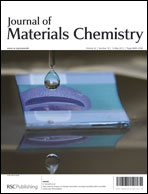Oligothiophene-functionalized naphthalimides and perylene imides: design, synthesis and applications†
Abstract
The syntheses of a variety of oligothiophene-functionalized naphthalimides and perylene imides have provided fundamental understanding of energy and charge carrier generation/flow at the molecular level. The correlation of the electrochemical and photophysical properties with their molecular structures is crucial for rational exploration of new materials for (opto)electronic applications including organic solar cells (OSCs), dye sensitized solar cells (DSSCs) and organic field effect transistors (OFETs). This review surveys the different structural modifications carried out in these molecular ensembles with special attention to the electrochemical and photophysical properties of these materials and the relationship with their properties which have allowed, among others, the rational design of ambipolar semiconductors for OFETs. These types of ensembles have been also employed in the investigation of novel molecular design strategies to tailor organic p–n heterojunctions with molecular-level precision as well as in the development of new techniques for the direct characterization of the internal electronic structure of single bipolar molecular heterojunctions including subnanometre features of the intramolecular donor–acceptor interface.


 Please wait while we load your content...
Please wait while we load your content...